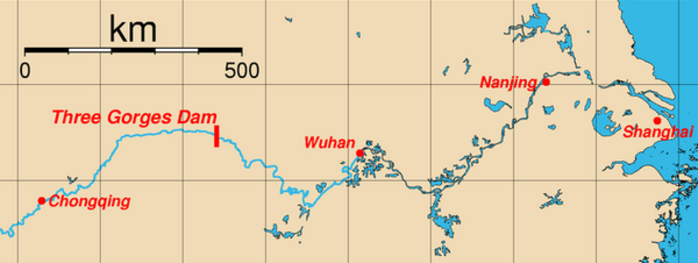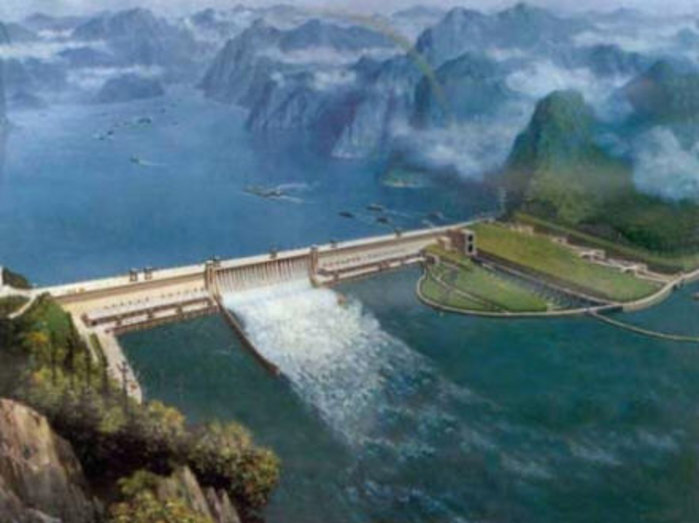Lessons from China's Three Gorges Dam
Peter Bosshard Via Japanfocus.org
The world's largest hydropower project has reached its final dimensions. Peter Bosshard draws conclusions from the Three Gorges experience.
Fifteen years after construction started, the water level of the Three Gorges reservoir is scheduled to reach its final height of 175 meters this fall. After 27 million cubic meters of cement have been poured, 39 cubic kilometers of water have been stored, and 1.3 million people have been resettled, it is time to take stock.
I have monitored the Three Gorges Project ever since the Swiss government approved export credits for it in the mid-1990s. I have discussed the project with Chinese government officials, affected people and environmental experts, and had the chance to visit the dam site this summer. I would like to offer the following conclusions from this experience for discussion:
• China completed the highly complex, challenging construction project ahead of schedule, which is rare in the international hydropower sector. Technically, the Three Gorges Dam is a masterpiece of Chinese engineering. The government insists that with a cost of $27.2 billion, the project was built within budget. Others claim that many costs do not appear in the official calculations, and that the project may cost up to $88 billion.
The Three Gorges Dam
• The hydropower project on the Yangzi River substitutes for burning at least 30 million tons of coal every year, which is more than 1 percent of China's total coal consumption. However, the Three Gorges Dam was not the only option for replacing coal. During the 2001-05 period, the energy efficiency of the Chinese economy dropped. According to Douglas Ogden of the Energy Foundation, it would have been "cheaper, cleaner and more productive for China to have invested in energy efficiency" rather than in new power plants.
• The dam has displaced more than 1.24 million people, and more people will need to be displaced to avoid an environmental disaster in the reservoir area. When I visited the Yangzi valley this summer, many people complained that compensation payments had been diverted into the pockets of local officials, and were not sufficient to pay for the new apartments. Citizens who protested against such corruption were frequently beaten up. Because it is no longer in the business of setting up new factories, the government was not able to fulfill its original promise to provide jobs to urban dwellers. Developing new farm land on steep hills also turned out to be unfeasible, so the government could not provide adequate land to most resettled farmers. Now that the project is complete, some areas have overcome the trauma of displacement, while others seem to be caught in a cycle of poverty and desperation. Either way, we have to acknowledge that displacing large numbers of people is becoming ever less feasible in densely populated China.
• The Three Gorges Dam is a massive intervention into the Yangzi's ecosystem. When it was converted into a stagnant water body, the river lost the ability to clean itself. Pollution from the submerged areas and the dirty industries along the shores are causing frequent toxic algae blooms. Important fish species such as the Chinese Sturgeon are threatened with extinction, and commercial fisheries in the Yangzi and off the river's mouth have plummeted. In September 2007, senior government officials warned that the project could turn into an environmental "catastrophe" if drastic measures were not taken.
A view of the dam from the International Space Station, June 3, 2009
• The water level of the Three Gorges reservoir fluctuates between 145 and 175 meters every year. This has already destabilized the slopes of the Yangzi Valley, and has created serious risks of erosion and landslides. More than 150 dangerous geological events were recorded within months after the reservoir was first impounded. According to the magazine Caijing (Finance), erosion affects slightly more than half the reservoir area, and 178 kilometers of riverbanks are at risk of collapsing. The project authorities had not predicted such a serious threat to the region. Addressing it will be very costly, and may require moving more than 500,000 additional people out of the region.
Landslide along the river (International Rivers), July 2009
• Since most of the silt load from the Yangzi's upper and middle reaches is now deposited in the reservoir, the downstream regions are being starved of sediment. As a consequence, up to 4 square kilometers of coastal wetlands are eroded every year. The Yangzi Delta is subsiding, and seawater is intruding up the river, affecting agriculture and drinking water supplies. Some scientists even suggest that changes in the Yangzi's nutrient load are responsible for the sudden explosion of giant jellyfish populations which hamper fisheries off the coast of Japan. While there are no in-depth studies on this phenomenon, the discussion illustrates that the ecological impacts of large dams are often too wide-ranging and complex to be predicted or controlled.
• Periodic floods have taken the lives of hundred thousands of people in the Yangzi Valley. The Three Gorges reservoir has created a buffer which mitigates these flood risks. On the other hand, the river's silt-free water is now scouring the banks downstream of the dam, which undermines these benefits. The project also increases the exposure of Shanghai to typhoons by eroding the coastline, and creates seismic risks in the Yangzi Valley. The Three Gorges Dam sits on two fault lines, and hundreds of small tremors have been recorded since the reservoir began filling. While the dam has been built to withstand strong earthquakes, the villages and towns in its vicinity have not. It is difficult to balance these risks with the increased flood protection which the dam may offer in the lower Yangzi Valley.
• In November 2009, the project authorities realized that they could not raise the water level in the reservoir to 175 meters as planned. They were surprised by the drought in the lower Yangzi Valley and, some observers say, needed to protect the banks of the reservoir from further landslides. The discussion about the appropriate water level indicates that there are difficult trade-offs between flood protection, electricity generation, environmental flows and the protection of the catchment area. These interests will continue to collide in the future operation of the reservoir.
In recent years, the Chinese government has strengthened the laws and regulations pertaining to dam construction, and has expanded the powers of the new Ministry of Environmental Protection. The government has set very ambitious goals for the promotion of energy efficiency and renewable energy. China is on track to improve the energy intensity of its economy by 20% by 2010, and to generate 15% of all energy from renewable sources (wind, biomass, solar and small hydro) by 2020. While the Three Gorges Dam comes across as a model of the past if all impacts are considered, China is now positioning itself as a global leader in the energy technologies of the future.
The Chinese government has also decided to retroactively compensate the 18 million people who have been displaced by dams in China with a yearly sum of $75 for 20 years. This act of restitution is unprecedented, and many other countries could learn from it.
At the same time, important gaps remain. Most resettlers in the Yangzi Valley have still not been adequately compensated. The Ministry of Environmental Protection often receives the environmental impact assessments of dam projects too late in the process, and does not have sufficient resources to review all of them thoroughly. Fines for the violation of environmental laws and regulations are too low to ensure effective compliance. Now that the Three Gorges Project has been completed, the government should commission a thorough independent evaluation of its costs and benefits. If it is acknowledged that large dams create irreversible social and environmental damage, low-impact alternatives such as energy efficiency and renewable energy technologies become all the more attractive.





1 Comments:
Great post, thank you. I'm going to put this in my next newsletter issue with links to your site.
Post a Comment
<< Home